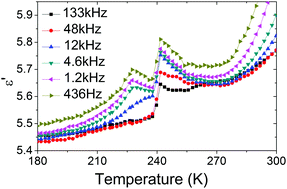Temperature- and pressure-dependent studies of a highly flexible and compressible perovskite-like cadmium dicyanamide framework templated with protonated tetrapropylamine†
Abstract
We report temperature-dependent X-ray diffraction, thermal, dielectric, electron paramagnetic resonance (EPR), Raman and IR studies of [(C3H7)4N][Cd(N(CN)2)3] ([TPrA][Cd(dca)3]) exhibiting a rich sequence of temperature-induced phase transitions occurring at T3 = 386 K, T2 = 362 K, T1 = 241 K and T0 = 228 K. The X-ray diffraction study confirms the I4/mcm, P![[4 with combining macron]](https://www.rsc.org/images/entities/char_0034_0304.gif) 21c and P21/n symmetry of the high-temperature phase, the phase stable between T2 and T1 and the low-temperature phase stable below T0, respectively. Our data show that the driving forces for the phase transitions at T3 and T2 are the partial ordering of the tetrapropylammonium cations (TPrA+) and dicyanamide (dca) linkers as well as the off-center shifts of TPrA+ cations and the tilting of the CdN6 octahedra. X-ray diffraction data reveal that two low-temperature (LT) structural phase transitions at T1 and T0 are associated with strong monoclinic distortion of the [Cd(dca)3]− framework and further ordering of the TPrA+ cations and dca linkers. Raman and EPR data confirm the strong distortion of the framework, while dielectric data are consistent with the partial ordering of the TPrA+ cations at T1. Dielectric and Raman data also prove that the phase transition at T0 is associated with further freezing of the propyl groups’ motions of the TPrA+ cations, whereas EPR data indicate that this phase transition is also associated with some distortion of the cadmium-dicyanamide framework. In the family of [TPrA][M(dca)3] compounds (M = Cd2+, Mn2+, Fe2+, Co2+, Ni2+), phase transitions into monoclinic phases are unique only for the Cd analogue, and our data indicate that this behaviour can be attributed to the higher flexibility of the [TPrA][Cd(dca)3] framework compared to the other analogues. We also report high-pressure X-ray powder diffraction and Raman studies of [TPrA][Cd(dca)3]. Fitting of the pressure dependence of the unit cell volume to the third order Birch–Murnaghan equation of state gives a bulk modulus of 6.2(6) GPa and its pressure derivative B′ = 12(2). The small value of the bulk modulus demonstrates the highly compressible nature of [TPrA][Cd(dca)3]. X-ray diffraction and Raman data show that this compound undergoes a pressure-induced phase transition between 0.3 and 0.4 GPa into a monoclinic structure, probably the same as that observed at ambient pressure below T0.
21c and P21/n symmetry of the high-temperature phase, the phase stable between T2 and T1 and the low-temperature phase stable below T0, respectively. Our data show that the driving forces for the phase transitions at T3 and T2 are the partial ordering of the tetrapropylammonium cations (TPrA+) and dicyanamide (dca) linkers as well as the off-center shifts of TPrA+ cations and the tilting of the CdN6 octahedra. X-ray diffraction data reveal that two low-temperature (LT) structural phase transitions at T1 and T0 are associated with strong monoclinic distortion of the [Cd(dca)3]− framework and further ordering of the TPrA+ cations and dca linkers. Raman and EPR data confirm the strong distortion of the framework, while dielectric data are consistent with the partial ordering of the TPrA+ cations at T1. Dielectric and Raman data also prove that the phase transition at T0 is associated with further freezing of the propyl groups’ motions of the TPrA+ cations, whereas EPR data indicate that this phase transition is also associated with some distortion of the cadmium-dicyanamide framework. In the family of [TPrA][M(dca)3] compounds (M = Cd2+, Mn2+, Fe2+, Co2+, Ni2+), phase transitions into monoclinic phases are unique only for the Cd analogue, and our data indicate that this behaviour can be attributed to the higher flexibility of the [TPrA][Cd(dca)3] framework compared to the other analogues. We also report high-pressure X-ray powder diffraction and Raman studies of [TPrA][Cd(dca)3]. Fitting of the pressure dependence of the unit cell volume to the third order Birch–Murnaghan equation of state gives a bulk modulus of 6.2(6) GPa and its pressure derivative B′ = 12(2). The small value of the bulk modulus demonstrates the highly compressible nature of [TPrA][Cd(dca)3]. X-ray diffraction and Raman data show that this compound undergoes a pressure-induced phase transition between 0.3 and 0.4 GPa into a monoclinic structure, probably the same as that observed at ambient pressure below T0.



 Please wait while we load your content...
Please wait while we load your content...